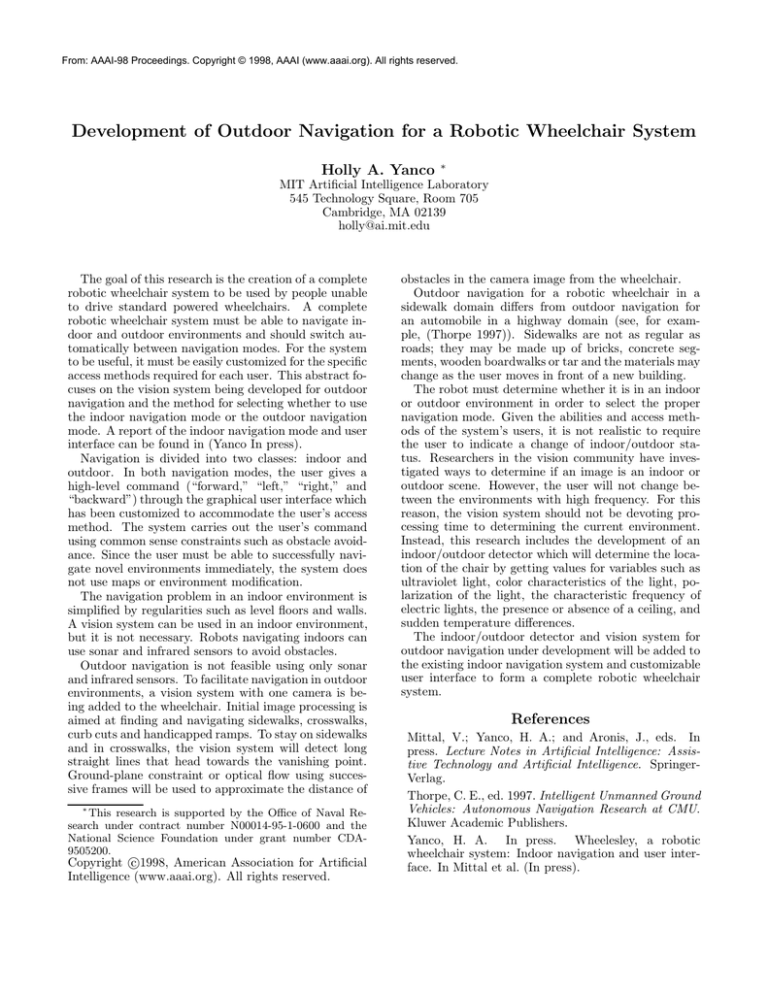
From: AAAI-98 Proceedings. Copyright © 1998, AAAI (www.aaai.org). All rights reserved.
Development of Outdoor Navigation for a Robotic Wheelchair System
Holly A. Yanco
∗
MIT Artificial Intelligence Laboratory
545 Technology Square, Room 705
Cambridge, MA 02139
holly@ai.mit.edu
The goal of this research is the creation of a complete
robotic wheelchair system to be used by people unable
to drive standard powered wheelchairs. A complete
robotic wheelchair system must be able to navigate indoor and outdoor environments and should switch automatically between navigation modes. For the system
to be useful, it must be easily customized for the specific
access methods required for each user. This abstract focuses on the vision system being developed for outdoor
navigation and the method for selecting whether to use
the indoor navigation mode or the outdoor navigation
mode. A report of the indoor navigation mode and user
interface can be found in (Yanco In press).
Navigation is divided into two classes: indoor and
outdoor. In both navigation modes, the user gives a
high-level command (“forward,” “left,” “right,” and
“backward”) through the graphical user interface which
has been customized to accommodate the user’s access
method. The system carries out the user’s command
using common sense constraints such as obstacle avoidance. Since the user must be able to successfully navigate novel environments immediately, the system does
not use maps or environment modification.
The navigation problem in an indoor environment is
simplified by regularities such as level floors and walls.
A vision system can be used in an indoor environment,
but it is not necessary. Robots navigating indoors can
use sonar and infrared sensors to avoid obstacles.
Outdoor navigation is not feasible using only sonar
and infrared sensors. To facilitate navigation in outdoor
environments, a vision system with one camera is being added to the wheelchair. Initial image processing is
aimed at finding and navigating sidewalks, crosswalks,
curb cuts and handicapped ramps. To stay on sidewalks
and in crosswalks, the vision system will detect long
straight lines that head towards the vanishing point.
Ground-plane constraint or optical flow using successive frames will be used to approximate the distance of
∗
This research is supported by the Office of Naval Research under contract number N00014-95-1-0600 and the
National Science Foundation under grant number CDA9505200.
c
Copyright 1998,
American Association for Artificial
Intelligence (www.aaai.org). All rights reserved.
obstacles in the camera image from the wheelchair.
Outdoor navigation for a robotic wheelchair in a
sidewalk domain differs from outdoor navigation for
an automobile in a highway domain (see, for example, (Thorpe 1997)). Sidewalks are not as regular as
roads; they may be made up of bricks, concrete segments, wooden boardwalks or tar and the materials may
change as the user moves in front of a new building.
The robot must determine whether it is in an indoor
or outdoor environment in order to select the proper
navigation mode. Given the abilities and access methods of the system’s users, it is not realistic to require
the user to indicate a change of indoor/outdoor status. Researchers in the vision community have investigated ways to determine if an image is an indoor or
outdoor scene. However, the user will not change between the environments with high frequency. For this
reason, the vision system should not be devoting processing time to determining the current environment.
Instead, this research includes the development of an
indoor/outdoor detector which will determine the location of the chair by getting values for variables such as
ultraviolet light, color characteristics of the light, polarization of the light, the characteristic frequency of
electric lights, the presence or absence of a ceiling, and
sudden temperature differences.
The indoor/outdoor detector and vision system for
outdoor navigation under development will be added to
the existing indoor navigation system and customizable
user interface to form a complete robotic wheelchair
system.
References
Mittal, V.; Yanco, H. A.; and Aronis, J., eds. In
press. Lecture Notes in Artificial Intelligence: Assistive Technology and Artificial Intelligence. SpringerVerlag.
Thorpe, C. E., ed. 1997. Intelligent Unmanned Ground
Vehicles: Autonomous Navigation Research at CMU.
Kluwer Academic Publishers.
Yanco, H. A. In press. Wheelesley, a robotic
wheelchair system: Indoor navigation and user interface. In Mittal et al. (In press).


